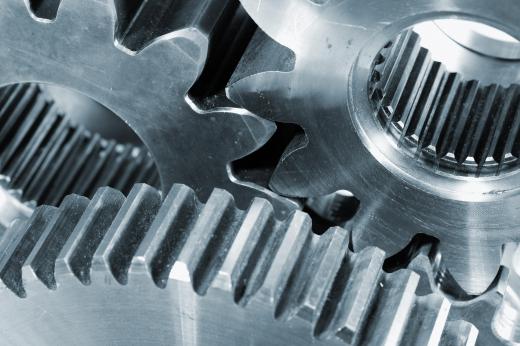A gear train is a series of gears that work together. This group of gears can be powered in a number of ways and is effective for changing one form of power into another to perform whatever function is needed. Gear trains can be found on almost all mechanical devices and vary in size depending on their function.
One of the first evolutions of simple machines, the gear train incorporates both the wheel and the lever. When multiple gears are used together they can perform tasks requiring greater force than can be provided by just a single gear. A small gear being rotated by a motor may spin a larger one, for example. The larger gear is capable of moving larger objects than the smaller gear is capable of, but due to the use of small gears to power its rotation, the large gear doesn’t need a larger, less efficient motor in order to work.

Different names are traditionally given to the gears in a train. The gear providing the source of power to the gear train is called the driver, while the final gear in the train that receives the energy is called the driven gear. Gears in between these two are referred to as idlers.
The amount of energy that each gear is capable of transferring depends on the number of teeth and the size. Each gear in a gear train reverses the direction of the rotation that it receives. These two factors must be considered as the amount of force and the direction of force the driven gear receives must be the precise kinds needed for the device being powered.
In order to achieve the proper end amount and direction of power, many different kinds of gears may be used in a gear train. Along with the typical rounded spur gears, which are essentially wheels with rows of teeth in them, there are rack and pinion gears which transfer energy from a spur gear to a belt or screw. Bevel gears are common as well. These are thicker versions of spur gears and are used to transfer energy from a spur gear at a 90 degree angle. Spur gears may be set inside of one another to transfer rotating energy into revolving energy.
A gear train is one of the oldest and most practical means of transferring mechanical power. From early water wheels to modern combustion engines they are used in almost all mechanical settings and can work together with technology that is thousands of years newer and older. Even when other forms of older technology become obsolete and are replaced with newer more complex forms, it is likely that gear trains will still be in common use.
